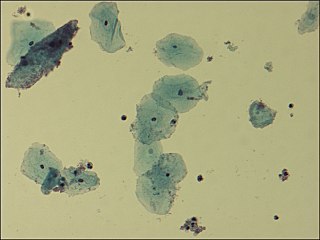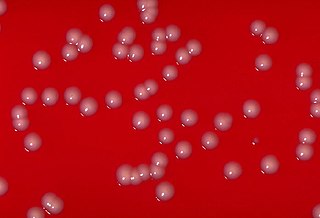Related Research Articles

Proteobacteria is a major phylum of Gram-negative bacteria. They include a wide variety of pathogenic genera, such as Escherichia, Salmonella, Vibrio, Helicobacter, Yersinia, Legionellales, and many others. Others are free-living (nonparasitic) and include many of the bacteria responsible for nitrogen fixation.

Gardnerella is a genus of Gram-variable-staining facultative anaerobic bacteria of which Gardnerella vaginalis is the only species. The organisms are small non-spore-forming, nonmotile coccobacilli.
The HACEK organisms are a group of fastidious Gram-negative bacteria that are an unusual cause of infective endocarditis, which is an inflammation of the heart due to bacterial infection. HACEK is an abbreviation of the initials of the genera of this group of bacteria: Haemophilus, Aggregatibacter, Cardiobacterium, Eikenella, Kingella. The HACEK organisms are a normal part of the human microbiota, living in the oral-pharyngeal region.

Corynebacterium is a genus of bacteria that are Gram-positive and aerobic. They are bacilli (rod-shaped), and in some phases of life they are, more particularly, club-shaped, which inspired the genus name.

The bacterial capsule is a very large structure of many bacteria. It is a polysaccharide layer that lies outside the cell envelope, and is thus deemed part of the outer envelope of a bacterial cell. It is a well-organized layer, not easily washed off, and it can be the cause of various diseases.

The Pasteurellaceae comprise a large family of Gram-negative bacteria. Most members live as commensals on mucosal surfaces of birds and mammals, especially in the upper respiratory tract. Pasteurellaceae are typically rod-shaped, and are a notable group of facultative anaerobes. Their biochemical characteristics can be distinguished from the related Enterobacteriaceae by the presence of oxidase, and from most other similar bacteria by the absence of flagella.

Haemophilus is a genus of Gram-negative, pleomorphic, coccobacilli bacteria belonging to the family Pasteurellaceae. While Haemophilus bacteria are typically small coccobacilli, they are categorized as pleomorphic bacteria because of the wide range of shapes they occasionally assume. These organisms inhabit the mucous membranes of the upper respiratory tract, mouth, vagina, and intestinal tract. The genus includes commensal organisms along with some significant pathogenic species such as H. influenzae—a cause of sepsis and bacterial meningitis in young children—and H. ducreyi, the causative agent of chancroid. All members are either aerobic or facultatively anaerobic. This genus has been found to be part of the salivary microbiome.
Paraburkholderia caledonica is a species of Proteobacteria.
Aggregatibacter actinomycetemcomitans is a Gram-negative, facultative anaerobe, nonmotile bacterium that is often found in association with localized aggressive periodontitis, a severe infection of the periodontium. It is also suspected to be involved in chronic periodontitis. Less frequently, A. actinomycetemcomitans is associated with nonoral infections such as endocarditis. Its role in aggressive periodontitis was first discovered by Danish-born periodontist Jørgen Slots, a professor of dentistry and microbiology at the University of Southern California School of Dentistry.

Actinobacillus is a genus of Gram-negative, nonmotile and non-spore-forming, oval to rod-shaped bacteria occurring as parasites or pathogens in mammals, birds, and reptiles. It is a member of the Pasteurellaceae family. The bacteria are facultatively anaerobic or aerobic, capable of fermenting carbohydrates, and of reducing nitrates. The genomic DNA contains between 40 and 47 mol % guanine plus cytosine.
Porphyromonas is a Gram-negative, non-spore-forming, obligately anaerobic and non-motile genus from the family of Porphyromonadaceae. This genus has been found to be part of the salivary microbiome. The use of targeted 16S rRNA gene metagenomic sequencing has shown that the genus is well represented in healthy individuals from the Human Microbiome Project.
Aggregatibacter is a genus in the phylum Proteobacteria (Bacteria), which contains three species, namely:

The genus Raoultella is composed of Gram-negative, oxidase-negative, aerobic, nonmotile, capsulated, facultatively anaerobic rods in the family Enterobacteriaceae. It is named after the French bacteriologist Didier Raoult.
Conserved signature inserts and deletions (CSIs) in protein sequences provide an important category of molecular markers for understanding phylogenetic relationships. CSIs, brought about by rare genetic changes, provide useful phylogenetic markers that are generally of defined size and they are flanked on both sides by conserved regions to ensure their reliability. While indels can be arbitrary inserts or deletions, CSIs are defined as only those protein indels that are present within conserved regions of the protein.
Atopobium vaginae is a species of bacteria in the genus of Actinobacteria, in the family Coriobacteriaceae. It is a facultative anaerobic, Gram-positive rod-shaped or elliptical coccobacilli found as single elements or in pairs or short chains. It is typically isolated from 80% of women with bacterial vaginosis and it is implicated in treatment failures. Invasive infections such as bacteremia have been reported.
Haemophilus felis is a Gram-negative species of bacterium belonging to the Pasteurellaceae family. A strain of this species was originally isolated from the respiratory tract of a cat with chronic obstructive pulmonary disease, though it was also found in healthy cats. The species may be closely related to Pasteurella multocida.
Haemophilus pittmaniae is a Gram-negative species of bacterium belonging to the Pasteurellaceae family. Strains of this species were originally isolated from humans. The species may be associated with respiratory infections in individuals with lung disease.
Elizabethkingia is a genus of bacterium described in 2005, named after Elizabeth O. King, the discoverer of the type species. Before this genus being formed in 2005, many of the species of Elizabethkingia were classified in the Chryseobacterium genus. Elizabethkingia has been found in soil, rivers, and reservoirs worldwide.
N-glycosyltransferase is an enzyme in prokaryotes which transfers individual hexoses onto asparagine sidechains in substrate proteins, using a nucleotide-bound intermediary, within the cytoplasm. They are distinct from regular N-glycosylating enzymes, which are oligosaccharyltransferases that transfer pre-assembled oligosaccharides. Both enzyme families however target a shared amino acid sequence asparagine—-any amino acid except proline—serine or threonine (N–x–S/T), with some variations.
Histophilus somni is a Gram-negative, pleomorphic, coccobacillus bacterium belonging to the family Pasteurellaceae.
References
- ↑ Nørskov-Lauritsen N (April 2014). "Classification, identification, and clinical significance of Haemophilus and Aggregatibacter species with host specificity for humans". Clinical Microbiology Reviews. 27 (2): 214–40. doi:10.1128/CMR.00103-13. PMC 3993099 . PMID 24696434.
- ↑ Kilian M (March 1976). "A taxonomic study of the genus Haemophilus, with the proposal of a new species". Journal of General Microbiology. 93 (1): 9–62. doi: 10.1099/00221287-93-1-9 . PMID 772168.